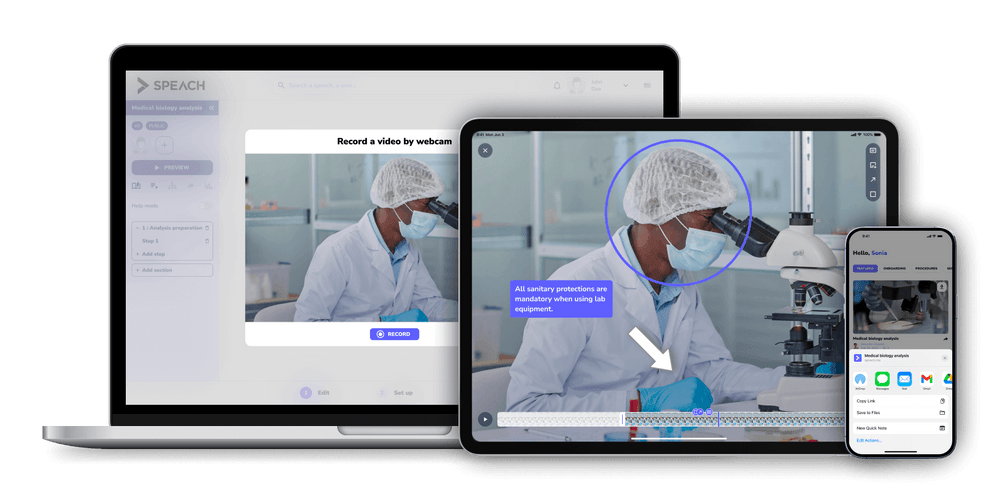1- Introduction
In the meticulous world of the manufacturing industry, the onboarding and continuous training of plant employees is not just a matter of compliance, but a cornerstone of operational success. The transition from informal, on-the-job training to a structured and standardized approach can seem daunting. However, with the advent of digital training platforms like Speach, this transformation is not only attainable but can also be seamlessly integrated into the very fabric of daily operations.
Imagine walking into a plant where the newest team member, on their first day, scans a QR code and is immediately presented with a concise, visually rich training module. They are guided through every nuance of their role, empowered by knowledge distilled from the company’s most experienced minds. This is not the training of tomorrow; it’s the innovation of today made possible through Speach.
In this comprehensive guide, we will walk you through the critical steps to implement a standardized training program using Speach. From capturing the tacit knowledge of Subject Matter Experts (SMEs) to creating bite-sized, interactive content tailored for each production station, we will show you how to transform your employee training into a strategic advantage. By the end of this journey, you'll see how Speach doesn't just make training more effective; it revolutionizes the way knowledge is transferred and retained.
So, whether you’re taking the first step towards formalizing your training processes or seeking to elevate an existing program, let’s explore how Speach can lay the foundation for a new era of excellence in your plant’s operations.

2 - Understanding the Need for Change
In the life sciences industry, where precision is non-negotiable and compliance is law, the reliance on informal training methods such as shadowing or ad-hoc on-the-job instruction is a precarious stance. These methods, while steeped in tradition and perceived flexibility, are fraught with inconsistencies and risks that can no longer be overlooked.
2-1 The Pitfalls of Informal Training
For years, plants within this sector have depended on the tacit knowledge of experienced employees to guide newcomers. This informal approach has inherent flaws:
- Knowledge Gaps: Unstructured training often leads to significant gaps in knowledge, where critical information is omitted or miscommunicated.
- Lack of Traceability: Without formal documentation, tracking an operator's training progress or verifying their understanding of complex procedures becomes difficult, if not impossible.
- Variable Quality: The quality of training is only as good as the individual delivering it, leading to variability in skill levels and competencies among operators.
- Regulatory Challenges: Informal methods are a gamble against ever-tightening regulatory scrutiny, where the absence of standardized training can lead to non-compliance and potential violations.
2-2 The Call for Standardization
The need for a structured, standardized approach is crystal clear. A standardized method can:
- Ensure Consistency: By formalizing training, every operator receives the same high-quality instruction, reducing variability in performance.
- Enable Scalability: As operations expand, a formalized training program can grow with the plant, ensuring that new employees are trained efficiently and effectively.
- Facilitate Compliance: Standardized training makes regulatory compliance simpler, with clear records and benchmarks that align with industry standards.
- Enhance Efficiency: A structured approach to training streamlines the learning process, allowing new operators to become productive members of the team faster.
2-3 Embracing a Digital Solution with Speach
The digital transformation of training methodologies is no longer optional but a strategic imperative. Speach emerges as the digital solution that addresses the pressing needs of the life sciences industry. It offers a way to encapsulate the expertise of seasoned professionals into standardized, engaging, and interactive training modules. By adopting Speach, plants can overcome the limitations of informal training and embark on a path to operational excellence that aligns with the industry's future.
In the next section, we will delve into the step-by-step process of how a life sciences plant can start implementing a training program with Speach, marking the beginning of a new standard in operational training and knowledge transfer.

3 - Step-by-Step Guide to Implementing a Training Program with Speach
When you're standing at the threshold of change, the journey ahead can seem daunting. But with Speach, transforming your plant's training program becomes a series of manageable, logical steps. Here's how to start:
Step 1: Initial Assessment and Planning
The inaugural step towards a groundbreaking training program begins with a meticulous assessment. Engage in a deep dive into the daily queries and recurring issues that new employees typically encounter. These repetitive questions and common challenges are not just pain points but opportunities for creating targeted training interventions.
Utilize these insights to craft a repository of ‘Speaches’—a series of focused, on-demand video guides that address these specific inquiries and difficulties. This proactive approach not only preempts the need for repeat support but also fosters a culture of self-service among new hires. By equipping them with readily accessible answers, you diminish the reliance on peer assistance and enhance operational efficiency from day one.
Moreover, this strategic assessment should prioritize documenting processes that frequently engender errors or non-compliance risks. By converting these into standardized Speach modules, you’re laying the groundwork for a robust training program that not only educates but also preemptively mitigates potential operational bottlenecks.
Step 2: Engaging Subject Matter Experts
Subject Matter Experts (SMEs) are your gold mine for content. Engage with them to identify the key tasks and procedures that need documentation. Encourage them to share not just the 'how' but also the 'why' behind each process. Their insights are invaluable to creating content that resonates with new operators.
Transitioning the wealth of knowledge from your Subject Matter Experts (SMEs) into a permanent digital format is akin to capturing lightning in a bottle. Ask SMEs to document their procedures and insights as if they are explaining them to a new team member — the catch is, they only have to do it once. This one-time investment in recording their knowledge pays dividends every time a new employee accesses a Speach.
Emphasize the importance of authenticity and the personal touch in these recordings. Encourage SMEs to speak in their own words, as if they're side-by-side with the learner on the shop floor. This approach retains the essence of hands-on or shadow training, fostering a connection that textbook-style materials can't replicate. It's about preserving the nuances of their everyday language and the subtleties that come with years of experience.
In doing so, each Speach becomes more than just a training tool; it is the virtual presence of an SME guiding the trainee through the learning process. For workers on the floor, it's the next best thing to learning from their peers in real life, creating a more relatable and engaging learning experience that mirrors the natural flow of on-the-job knowledge sharing.
Step 3: Content Creation and Enhancement with Speach Tools
Empower your Subject Matter Experts (SMEs) to become the architects of your training content right where the action happens - on the plant floor. With the Speach mobile app, SMEs can capture the intricacies of their tasks with ease, recording the nuanced procedures and machine operations as they perform them. This on-the-spot content creation ensures authenticity and relevance, reflecting the real-world scenarios new employees will face.
Once the raw footage is gathered, it's over to the training & quality team to refine and enrich the content. Leveraging the Speach platform on their computers, trainers can edit the videos for clarity, add annotations for emphasis, and pair the visuals with comprehensive documentation. The real magic happens when assessments are embedded directly into the content, transforming passive watching into interactive learning experiences.
This collaborative approach between SMEs and the training and quality team ensures that the content is not only expert-driven but also pedagogically sound and engaging. By using the strengths of Speach's mobile and desktop applications in tandem, the training content becomes a powerful tool in standardizing procedures and ensuring competency across the workforce.

Step 4: Prioritizing and Structuring the Training Content
The key to a successful training program is not just in the content, but in its structure and priority. Begin by listing out all the procedures, especially those that are complex or not commonly known, which can often cause bottlenecks or safety concerns if not performed correctly. Such procedures might include specialized equipment handling, intricate quality control checks, or processes that are critical to product integrity.
To determine which procedures to encapsulate in Speach first, consider the following criteria:
Incidence of Errors and Defects: Prioritize procedures where there's a history or likelihood of human error leading to defects or non-conformities. These are critical for maintaining quality and safety standards.
Frequency of Use: How often is the procedure performed? Daily tasks should be prioritized over those done monthly or yearly.
Criticality: Assess the impact of the task on the overall operation. Tasks that have high significance for safety, compliance, and product quality should be at the top of the list.
Complexity: The more complex a task, the more likely it is to be misunderstood or performed incorrectly. These tasks need clear, step-by-step guidance.
Expert Availability: If only a few experts know how to handle a procedure, it's vital to document their knowledge before it becomes a single point of failure.
Training Demand: Pay attention to the training requests from the floor. If a particular topic is frequently asked about, it indicates a training need.
Once you've determined which procedures to prioritize, organize them into a curriculum that mirrors the learning journey of an employee. Start with the basics and build up to the more complex tasks, ensuring each module builds upon the previous one. This progressive structure will help new employees build confidence and competence as they advance through their training with Speach.
Step 5: Crafting Interactive Software Tutorials with Speach
In the digital era, life sciences manufacturing plants are increasingly reliant on a suite of sophisticated software to manage their operations. The proficiency of operators in utilizing these digital tools is as vital as their skill on the plant floor. A practical starting point for creating content on Speach is to develop step-by-step tutorials for business-critical software.
Streamlining Software Onboarding:
> Screen Recording: Utilize Speach's screen recording feature to capture live software interactions, creating a visual walkthrough that operators can mirror. This approach demystifies complex software interfaces and workflows.
> Voice Narration: Accompany these visual guides with voiceover explanations to contextualize each step and provide helpful tips, just as an expert would in a live training session.
> Clickable Hotspots: Enhance tutorials with interactive elements like clickable hotspots or markers to draw attention to important functions or data entry fields within the software.
Enhancing Engagement and Retention:
- Microlearning Modules: Break down software training into microlearning modules, each focusing on a specific task or feature. This segmentation makes the learning process more digestible and less overwhelming.
- Assessments and Quizzes: At the end of each module, embed quizzes or interactive assessments to reinforce learning objectives and gauge operator comprehension.
- Real-world Scenarios: Create scenario-based challenges within Speach that require operators to apply their software knowledge in simulated real-world situations.
Continuous Learning and Support:
- Just-in-time Learning: Make these Speach tutorials easily accessible for on-the-job reference, enabling operators to learn in the flow of work or refresh their memory as needed.
- Feedback Loop: Encourage operators to provide feedback on the tutorials, ensuring the content remains relevant and effective in addressing actual on-the-floor challenges.
- Iterative Updates: Regularly update the tutorials to reflect software updates or changes in operational procedures, thus maintaining the currency and accuracy of training materials.
By focusing on the digitization of software training, Speach becomes an integral part of the plant’s ecosystem, bridging the gap between technology and the workforce. This step ensures operators are equipped not only with the practical skills of their trade but also with the digital literacy required to excel in a modern manufacturing environment.
Step 6: Comprehensive Pilot Testing and Iterative Refinement
The pilot testing phase is a critical juncture in the implementation of your Speach-driven training program. This step serves as a litmus test for the effectiveness of your content and the robustness of your training structure.
Launching the Pilot:
- Select a Diverse Test Group:Assemble a group of new hires with varying levels of experience and familiarity with plant operations to ensure the pilot covers a broad range of perspectives.
- Introduce the Training Modules: Roll out the Speach modules you’ve prioritized, and allow the test group to engage with the content in a controlled environment. Monitor their interaction and progress closely.
- Set Clear Objectives: Establish what you aim to achieve with the pilot, whether it's assessing the clarity of the content, the usability of the platform, or the overall engagement level of the trainees.
Monitoring and Gathering Data:
- Track Progress: Use Speach’s analytics tools to monitor how trainees are interacting with the content. Are they completing the modules? Which sections are they revisiting?
- Record Feedback: Collect both qualitative and quantitative feedback from the participants. This could range from their confidence in performing tasks to their satisfaction with the learning experience.
- Observe Directly: Where possible, observe the trainees as they use the Speach content. Real-time observations can provide insights that data alone may not reveal.
Evaluating and Iterating:
- Assess Completion Rates: Evaluate how many participants are completing the training and how quickly they are doing so. Low completion rates or prolonged training times may indicate content or structure issues.
- Analyze Assessments: Review the results of embedded quizzes and assessments. Are there patterns in the mistakes being made? This could signal areas where the content needs to be improved.
- Implement Changes: Based on the data and feedback, make necessary adjustments to the content. This might include rephrasing instructions, adding additional visual aids, or restructuring the sequence of modules.
Refining for Rollout:
- Repeat Pilot if Necessary: If significant changes are made, consider running another pilot to ensure the revisions have had the desired effect.
- Prepare for Full Implementation: Once the content is refined and the pilot is successful, prepare for a full-scale rollout. Ensure all stakeholders are informed of the changes and trained on how to support the new program.
- Develop Support Structures: Establish a support system for trainees as they transition from the pilot to the full program. This could include mentorship from SMEs, peer support networks, or a helpdesk for Speach-related queries.
The pilot testing phase is not simply about validation but about learning and improving. It’s an opportunity to refine your training to perfection before it becomes the cornerstone of your plant’s learning culture. By embracing an iterative approach, you ensure that your training program will be as effective and engaging as possible when it's time for full implementation.
Step 7: Dynamic Updating and Compliance-Centric Versioning
With the foundation of your training program established and pilot-tested, the focus shifts to maintaining its relevance and effectiveness through dynamic updates. Speach’s platform is designed for agility and precision in content modification, ensuring that your training materials are not only up-to-date but also compliant with stringent GxP standards.
Continuous Improvement Through Targeted Updates:
- Incremental Enhancements: Based on feedback and completion rates, identify specific segments within a Speach that require refinement. You can update just these portions without having to overhaul the entire module, making improvements manageable and focused.
- Version Control: Each update is meticulously tracked and recorded within Speach’s system. This versioning not only provides a clear history of changes for audit purposes but also ensures that every operator accesses the most current information.
- GxP Compliance: Speach adheres to Good Practice (GxP) quality guidelines and regulatory requirements. Each iteration of your training content is automatically aligned with these compliance standards, providing peace of mind and reducing regulatory risk.
Ensuring Traceability and Accountability:
- Traceable Modifications: Maintain a transparent change log that captures who made an update, what was changed, and why. This traceability is crucial for internal quality assurance and external regulatory reviews.
- Accountability in Content Management: Assign roles and permissions within Speach to control who can make updates, ensuring that changes are only made by authorized personnel with the appropriate expertise.
- Review and Approval Workflows: Implement a structured review process for updates, requiring sign-off from key stakeholders before a new version is released. This gatekeeping ensures that all changes meet your plant’s operational and training standards.
Leveraging Feedback for Continuous Evolution:
- Actionable Insights: Use the analytics and feedback gathered to inform your content updates. If certain sections of a Speach show a pattern of incomplete views or failed assessments, these areas can be targeted for improvement.
- Responsive Adjustments: The agility of Speach allows for responsive updates. If a new best practice emerges or a process change is implemented, the relevant Speach can be quickly updated to reflect these developments.
- User-Driven Refinement: Encourage ongoing dialogue with your operators. Their hands-on experience can drive the evolution of training content, ensuring it remains practical and grounded in the realities of the plant floor.
By utilizing Speach’s update and versioning capabilities, you ensure that each piece of training content is not only a reflection of current best practices but also a living document that evolves alongside your operations. This approach to content management fosters an environment of continuous improvement and positions your training program as a benchmark for GxP-compliant knowledge dissemination.
Step 8: Scaling Up and Continuous Evolution
After ensuring your initial training content is precise, compliant, and well-received, it's time to think about scalability and long-term evolution. As your operations grow and change, so too must your training program. Speach provides the flexibility and tools necessary to expand and adapt your training modules to meet the demands of an evolving workforce and regulatory landscape.
Strategies for Scaling Your Training Program:
- Modular Design: Develop training content in modular formats, allowing for easy updates and the addition of new modules without disrupting the existing structure. This enables quick responses to new training needs as they arise.
- Template Creation: Establish templates for common types of Speach content. Templates can standardize the creation process, making it faster and more efficient to produce new content while ensuring consistency across all training materials.
- Cross-Departmental Expansion: Start with critical areas and then replicate the successful training framework across other departments. Each department can tailor the Speach platform to its specific needs, fostering a culture of learning across the entire organization.
Adapting to Technological and Process Changes:
- Agile Response to Changes: Maintain a proactive stance towards industry trends and technological advancements. Update training materials to reflect new equipment, software, or methodologies, ensuring your workforce remains at the forefront of industry competencies.
- Continuous Feedback Integration: Keep the lines of communication open with operators and SMEs. Their insights will guide the ongoing development of training content, ensuring it remains relevant and effective.
Maintaining GxP Compliance Amidst Growth:
- Update Compliance Protocols: As you scale, update your compliance protocols to ensure that training content across all levels and departments adheres to the latest GxP standards.
- Regular Audit Readiness: Implement regular reviews and audits of your training materials to ensure that they are always audit-ready, minimizing the risk of non-compliance as your plant grows and changes.
Evolving with the Workforce:
- Addressing New Learning Styles: As new generations enter the workforce, adapt your training to align with evolving learning styles and preferences, utilizing Speach's versatile content creation capabilities.
- Enhancing Accessibility: Ensure that training materials are accessible to all employees, including those with disabilities, and in all the languages needed for your diverse workforce.
Implementing Advanced Analytics for Insightful Decision-Making:
- Leverage Data for Strategic Growth: Use the advanced analytics provided by Speach to gain insights into how training impacts performance. This data will inform strategic decisions about where to invest in further training development.
- Predictive Analysis: Utilize analytics for predictive analysis to forecast future training needs based on trends in workforce performance and engagement with current modules.
By focusing on scalable solutions, continuous feedback, and compliance, your training program can grow alongside your plant, ensuring that your workforce remains skilled, knowledgeable, and prepared to meet both the current and future challenges of the life sciences industry.
By following these steps, your plant will not only create a standardized way of working but will also cultivate an environment where continuous improvement is the norm. Speach isn’t just a tool for creating training content; it's a platform for building a knowledge-sharing ecosystem that will drive your plant towards greater efficiencies and compliance.

4 - Benefits of a Standardized Training Program with Speach:
The adoption of Speach in a standardized training program introduces a multitude of benefits, such as improved consistency across the board. By implementing a 'train the trainers' program, Speach enables organizations to nominate 'ambassadors' who are adept at creating Speach modules. These ambassadors become pivotal in guiding others through the Speach creation process, promoting a sustainable, self-perpetuating training ecosystem. This approach not only reduces training time significantly but also elevates the quality of the content produced. Moreover, with these ambassadors spearheading the initiative, organizations can establish guidelines and best practices for creating effective and efficient Speach content. This, in turn, leads to higher retention rates as employees engage with high-caliber, peer-reviewed training material that is standardized yet personalized, ensuring a deeper understanding and application of learned skills.
5 - Conclusion:
The Speach platform is the cornerstone of a revolutionary shift in training within the life sciences industry. By fostering a 'train the trainers' culture and encouraging the development of training ambassadors, Speach empowers organizations to create a robust, self-sustaining training infrastructure. This standardization is not just about consistency; it's about creating a shared language of excellence and expertise across your organization.
Step into the future of training with Speach. Define your training ambassadors and leverage their expertise to cascade knowledge throughout your organization. Contact us for more information or to arrange a demonstration. Let's work together to craft guidelines and best practices that will shape the future of learning in your company with Speach. The journey to an empowered, informed, and skilled workforce starts here.
Key Points for the Step-by-Step Guide:
Identifying Training Needs and Goals:
Begin by conducting a thorough needs analysis to understand where the knowledge gaps lie and what the training program aims to achieve.
Engaging Subject Matter Experts (SMEs):
SMEs can start by recording welcoming procedures for new employees. This could be a walkthrough of the plant or an introduction to the team.
Recording and Documenting Processes:
Use Speach to record SMEs performing actual tasks on the production line, or capture screen recordings of them using software tools essential for the job.
Creating Visual Content for Each Production Station:
Develop visual guides for each production station, using Speach to create content that's both engaging and informative.
Utilizing Microlearning Principles:
Break down complex processes into smaller, manageable learning segments that can be easily digested by new employees.
Building Interactive Training Modules:
Leverage Speach’s capabilities to make modules interactive, perhaps by embedding quizzes or creating scenario-based training.
Implementing the Training Program:
Gradually roll out the training program, starting with a pilot group of new employees to test and refine the approach.
Feedback and Iteration:
Establish a feedback loop with new employees and use their insights to improve the training modules continuously.





